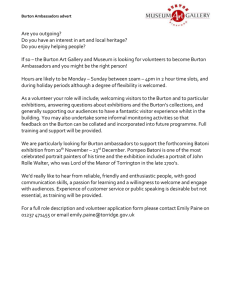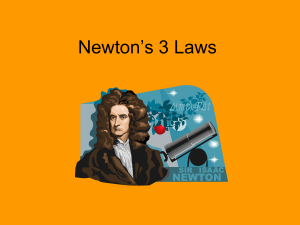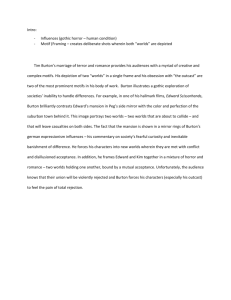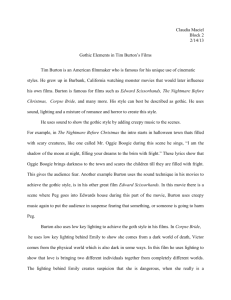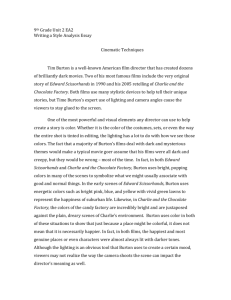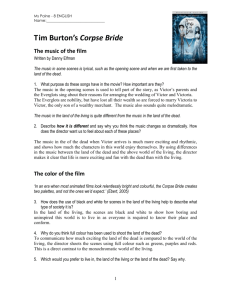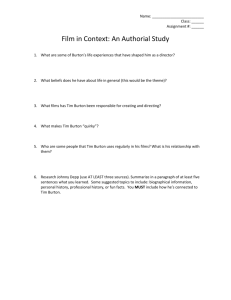Exemplary From Pee Wee's Big Adventure to Charlie and the Chocolat
advertisement
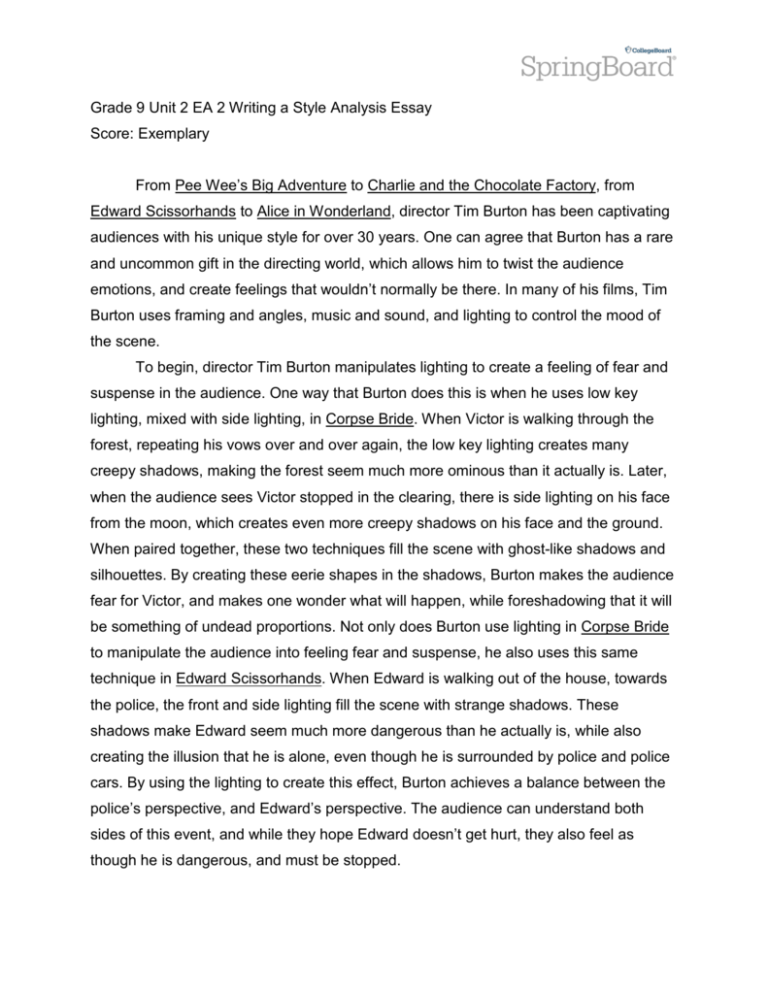
Grade 9 Unit 2 EA 2 Writing a Style Analysis Essay Score: Exemplary From Pee Wee’s Big Adventure to Charlie and the Chocolate Factory, from Edward Scissorhands to Alice in Wonderland, director Tim Burton has been captivating audiences with his unique style for over 30 years. One can agree that Burton has a rare and uncommon gift in the directing world, which allows him to twist the audience emotions, and create feelings that wouldn’t normally be there. In many of his films, Tim Burton uses framing and angles, music and sound, and lighting to control the mood of the scene. To begin, director Tim Burton manipulates lighting to create a feeling of fear and suspense in the audience. One way that Burton does this is when he uses low key lighting, mixed with side lighting, in Corpse Bride. When Victor is walking through the forest, repeating his vows over and over again, the low key lighting creates many creepy shadows, making the forest seem much more ominous than it actually is. Later, when the audience sees Victor stopped in the clearing, there is side lighting on his face from the moon, which creates even more creepy shadows on his face and the ground. When paired together, these two techniques fill the scene with ghost-like shadows and silhouettes. By creating these eerie shapes in the shadows, Burton makes the audience fear for Victor, and makes one wonder what will happen, while foreshadowing that it will be something of undead proportions. Not only does Burton use lighting in Corpse Bride to manipulate the audience into feeling fear and suspense, he also uses this same technique in Edward Scissorhands. When Edward is walking out of the house, towards the police, the front and side lighting fill the scene with strange shadows. These shadows make Edward seem much more dangerous than he actually is, while also creating the illusion that he is alone, even though he is surrounded by police and police cars. By using the lighting to create this effect, Burton achieves a balance between the police’s perspective, and Edward’s perspective. The audience can understand both sides of this event, and while they hope Edward doesn’t get hurt, they also feel as though he is dangerous, and must be stopped. Not only does Tim Burton use lighting to achieve a desired effect on the audience’s feelings, he also uses music and sound to mold the mood of the films. For example, Burton uses non-diegetic music in Charlie and the Chocolate Factory to emphasize the feelings of the children when they are let loose in the edible room. By using the music to explain the children’s thoughts and emotions, Burton allows the audience to gain a deeper understanding of the characters, and feel as though they are in the movie, not just watching it. This also allows the audience to experience the candy room through each of the children’s perspective, which creates a deeper connection between the character and the audience. Burton also uses non-diegetic music in Corpse Bride to again allow the audience into the character’s head. When Victor is running form the bride, Burton controls and changes the mood of the movie by using music when we first see the bride. As Victor rehearses his vows, there is a proud, almost triumphant feeling conveyed with sounding music, which allows the audience to understand how excited he is to have finally gotten them right. However, when Victor places the ring, unknowingly, on the bride’s figure the music changes to an ominous and frantic soundtrack, which made the mood of the audience go from happy for Victor, to scared for him as he runs from the bride. By changing the music and twisting the mood, burton allows the audience to know that Victor’s mood has changed as well. In addition to allowing the audience to gain a better understanding of the characters, Burton uses non-diegetic sound to foreshadow the events that are about to take place. A good example of this is in Edward Scissorhands. Near the end of the movie, Kevin is walking home from a friend’s house down the street, a seemingly average task. However, the ominous, non-diegetic music foreshadows the events that are about to take place are anything but average. When the audience sees the van speeding toward Kevin, one realizes that he is in danger, which was foreshadowed by the creepy music. By using this technique, Burton can create suspense in his films which would make the audience want to find out what will happen and therefore keep watching. Finally, director Tim burton uses framing and angles to again manipulate and change the mood of the film. A prime example of this is in Charlie and the Chocolate Factory. As Charlie stands outside of the factory, staring up at it, Burton uses a mixture of high and low angle to make Charlie seem small and the factory seem big. By using a low angle on the factory and a high angle on Charlie, Burton gives the feeling that Charlie feels week, powerless, and insignificant especially when he is compared to something as big and incredible as this world-renowned chocolate factory. Similarly, in Corpse Bride, Burton uses a low angle on the bride when she rises out of the ground. When the audience sees the bride from this angle, one can imagine how Victor sees her, and begins to feel frightened by her, because she appears so much larger than a normal sized person. It is not until later in the movie does one realize that she is actually an average-sized person. This effect is achieved because of the angle on the bride when the audience first sees her. Additionally, Burton uses a long shot in Edward Scissorhands when we see the mob of people enter the forest. By using a long shot, the audience can see both how many people there are, and their angry, almost crazed body language. When these two things are shown together in one shot, one can understand the gravity of the situation, and begins to fear for Edward’s life. Throughout all his films, director Tim Burton uses many film techniques and cinematic elements. However, when Burton wants to control the audiences’ emotions, and twist the mood of the scene, he uses lighting, non-diegetic music, and framing and angles to achieve the desired effect. By using his directing skills and combing these techniques, Burton creates incredible films that mesmerize people of all ages, and will enchant audiences for generations to come. Score: Exemplary Annotation An Exemplary literary analysis of style must be able to link Burton’s style to his use of cinematic techniques. The assertion that Tim Burton uses cinematic techniques to control the mood of the scene comes close to identifying a stylistic trait, though it is still fairly general. Extensive use of textual evidence of the effect of cinematic techniques from multiple films is a clear strength of this essay. Well-developed elaboration of the textual evidence and especially sophisticated transitional devices puts this exemplar firmly in the Exemplary proficiency band. The commentary enhances the specific evidence provided and is wide-ranging and insightful, showing a deep understanding of cinematic techniques and how they create specific effects in mood and atmosphere. The last paragraph brings the analysis to a satisfying and perceptive conclusion by returning to the central concept that Burton’s style is characterized by a desire to “control the audiences’ emotions, and twist the mood of the scene.” This control of the essay through organization and progression of ideas is supplemented by the precise use of cinematic vocabulary and generally sophisticated sentence structure and language.
